Related Research Articles

The latissimus dorsi is a large, flat muscle on the back that stretches to the sides, behind the arm, and is partly covered by the trapezius on the back near the midline. The word latissimus dorsi comes from Latin and means "broadest [muscle] of the back", from "latissimus" ' and "dorsum". The pair of muscles are commonly known as "lats", especially among bodybuilders. The latissimus dorsi is the largest muscle in the upper body.

The axillary nerve or the circumflex nerve is a nerve of the human body, that originates from the brachial plexus at the level of the axilla (armpit) and carries nerve fibers from C5 and C6. The axillary nerve travels through the quadrangular space with the posterior circumflex humeral artery and vein to innervate the deltoid and teres minor.
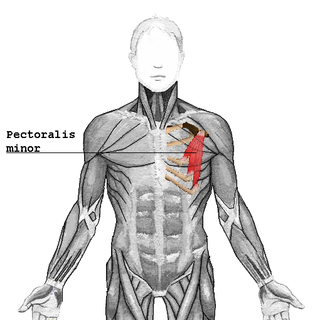
The pectoralis minor is a thin, triangular muscle, situated at the upper part of the chest, beneath the pectoralis major in the human body.
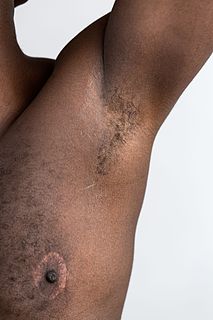
The axilla is the area on the human body directly under the joint where the arm connects to the shoulder. It also contains many sweat glands.
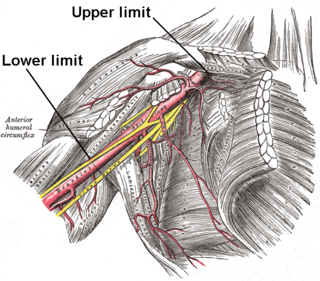
In human anatomy, the axillary artery is a large blood vessel that conveys oxygenated blood to the lateral aspect of the thorax, the axilla (armpit) and the upper limb. Its origin is at the lateral margin of the first rib, before which it is called the subclavian artery.
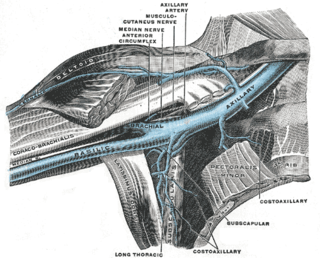
In human anatomy, the axillary vein is a large blood vessel that conveys blood from the lateral aspect of the thorax, axilla (armpit) and upper limb toward the heart. There is one axillary vein on each side of the body.

In human anatomy, the lateral thoracic artery is a blood vessel that supplies oxygenated blood to the lateral structures of the thorax and breast.
Axillary means "related to the axilla (armpit)" or "related to the leaf axils".

The subclavius is a small triangular muscle, placed between the clavicle and the first rib. Along with the pectoralis major and pectoralis minor muscles, the subclavius muscle makes up the Anterior Axioappendicular Muscles also known as anterior wall of the axilla.

The medial brachial cutaneous nerve is distributed to the skin on the medial brachial side of the arm.

The intercostobrachial nerves are cutaneous branches of the intercostal nerves.

The axillary sheath is a fibrous sheath that encloses the axillary artery and the three cords of the brachial plexus to form the neurovascular bundle, surrounded by the axillary fat. It is an extension of the prevertebral fascia of the deep cervical fascia.

The clavipectoral fascia is a strong fascia situated under cover of the clavicular portion of the pectoralis major.
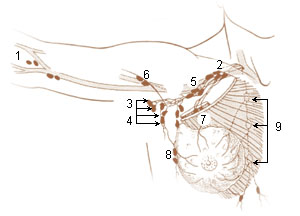
The tail of Spence is an extension of the tissue of the breast that extends into the axilla. It is actually an extension of the upper lateral quadrant of the breast. It passes into the axilla through an opening in the deep fascia called foramen of Langer.
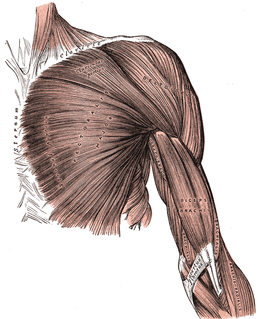
The pectoral fascia is a thin lamina, covering the surface of the pectoralis major, and sending numerous prolongations between its fasciculi: it is attached, in the middle line, to the front of the sternum; above, to the clavicle; laterally and below it is continuous with the fascia of the shoulder, axilla, and thorax.

A central or intermediate group of three or four large glands is imbedded in the adipose tissue near the base of the axilla.
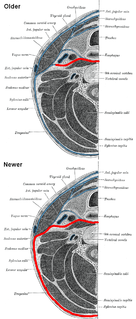
The prevertebral fascia is a fascia in the neck.

The axillary spaces are anatomic spaces. through which axillary contents leave the axilla. They consist of the quadrangular space, triangular space, and triangular interval. It is bounded by teres major, teres minor, medial border of the humerus, and long head of triceps brachii.
The suspensory ligament of axilla, or Gerdy's ligament, is a suspensory ligament that connects the clavipectoral fascia to the axillary fascia. This union shapes the axilla (underarm).
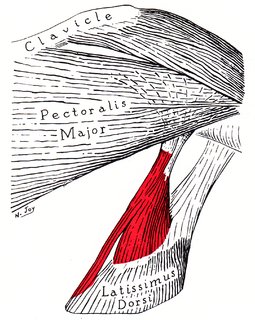
The axillary arch is a variant of the latissimus dorsi muscle in humans. It is found as a slip of muscle or fascia extending between the latissimus dorsi muscle and the pectoralis major. There is considerable variation in the exact position of its origin and insertions as well as its blood and nerve supply. Its presence in different ethnic groups varies, being present in about 7% of Europeans and with higher rates in the Chinese and less common in the Turkish population. The arch may occur on one or both sides of the body.
References
This article incorporates text in the public domain from page 436 of the 20th edition of Gray's Anatomy (1918)